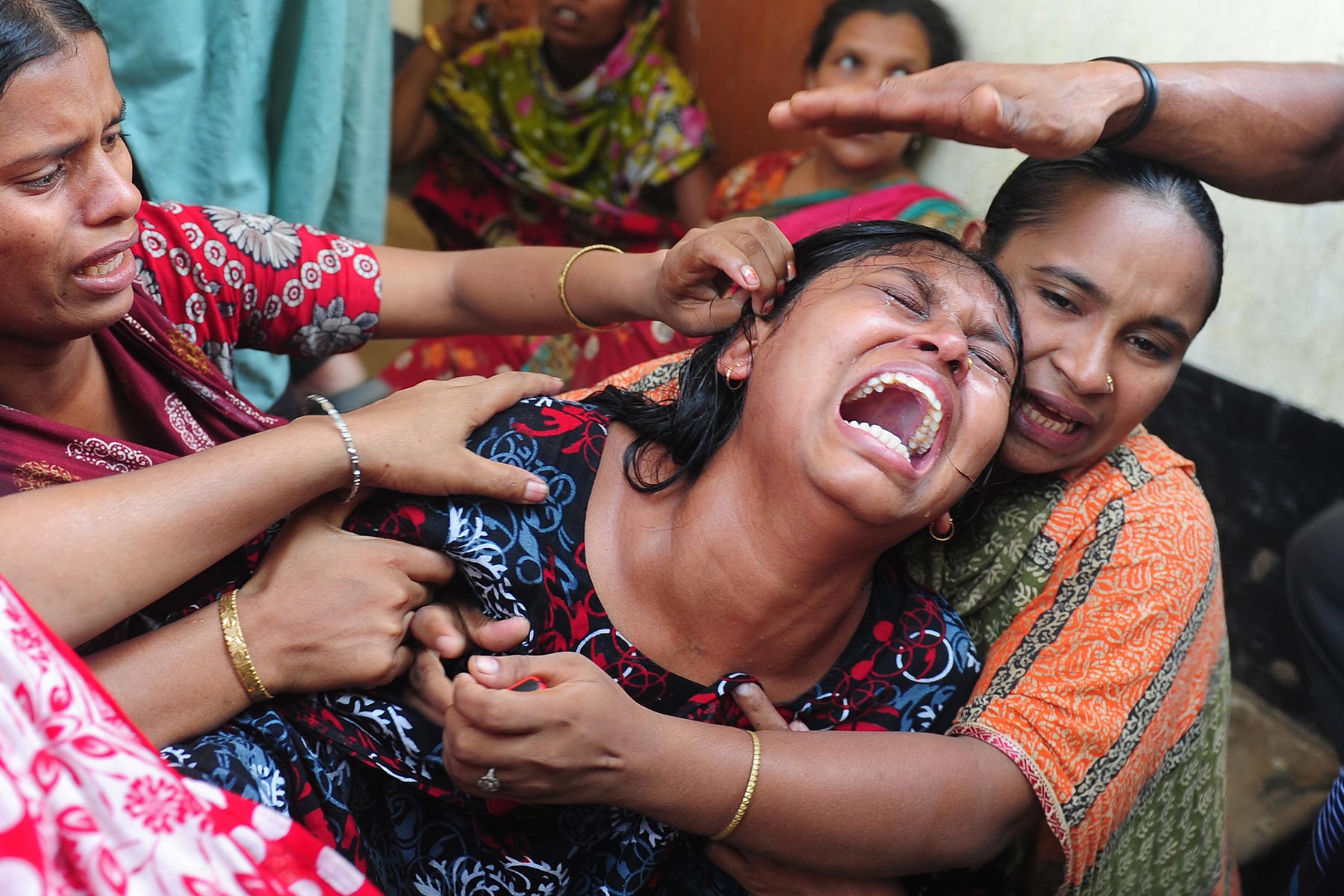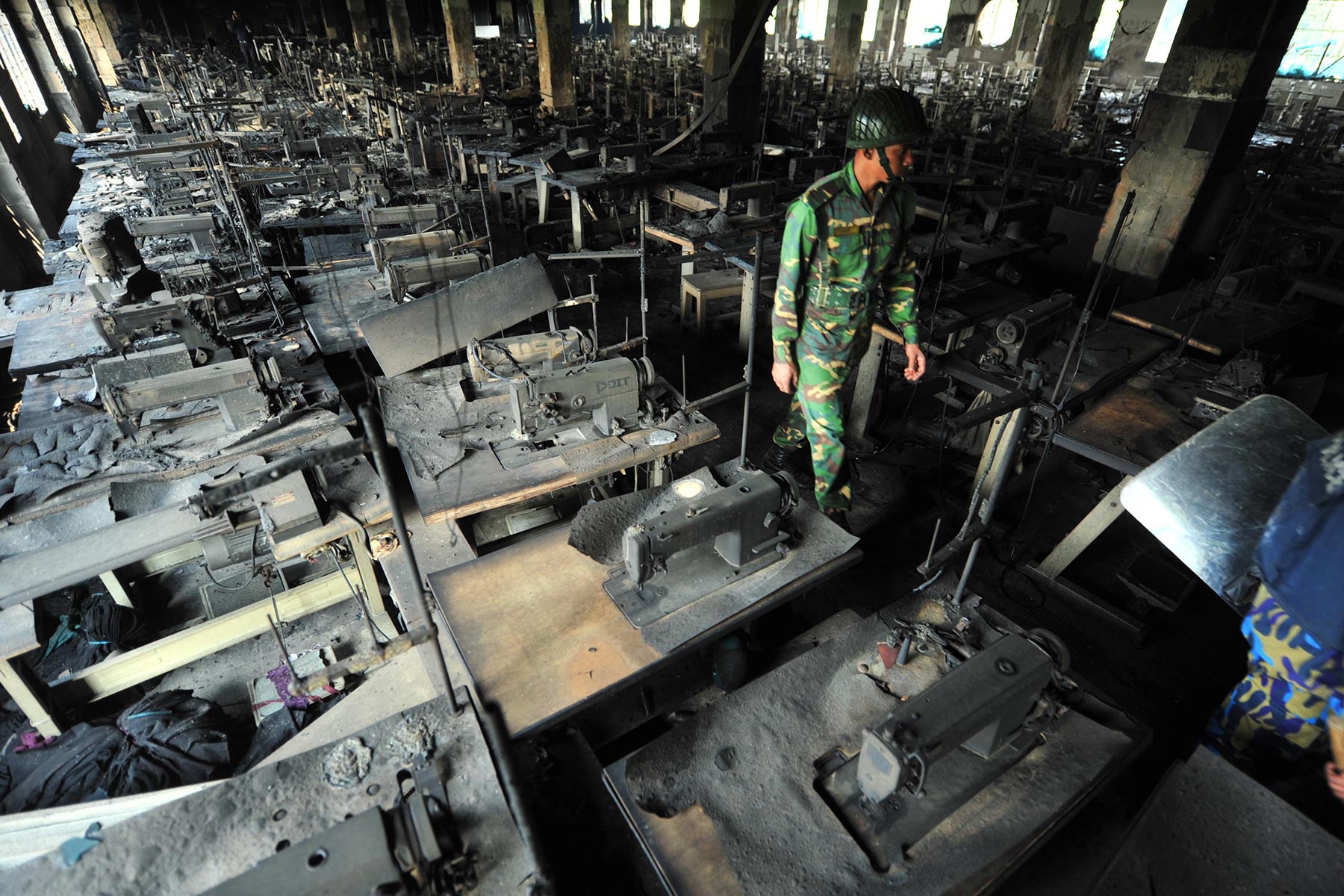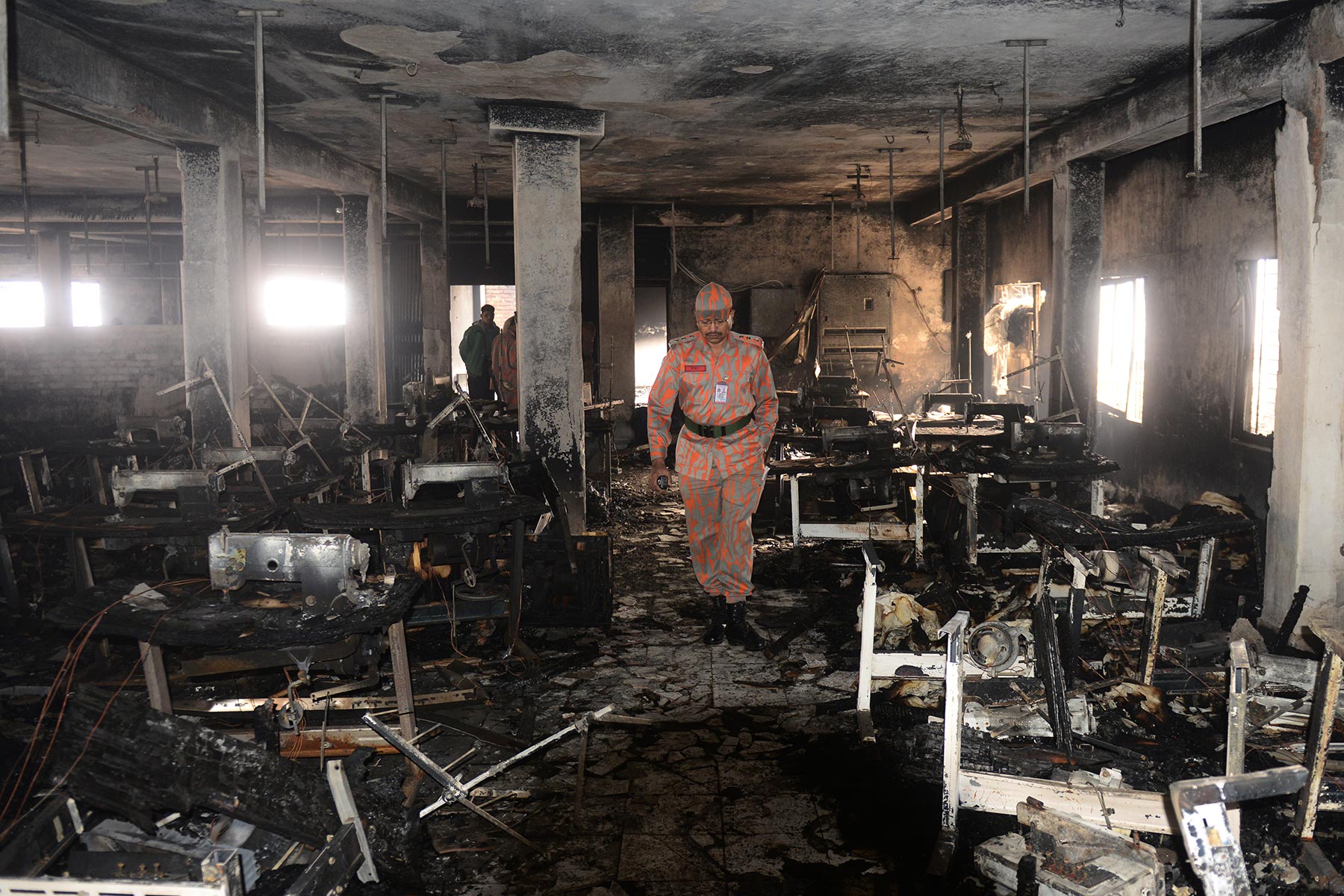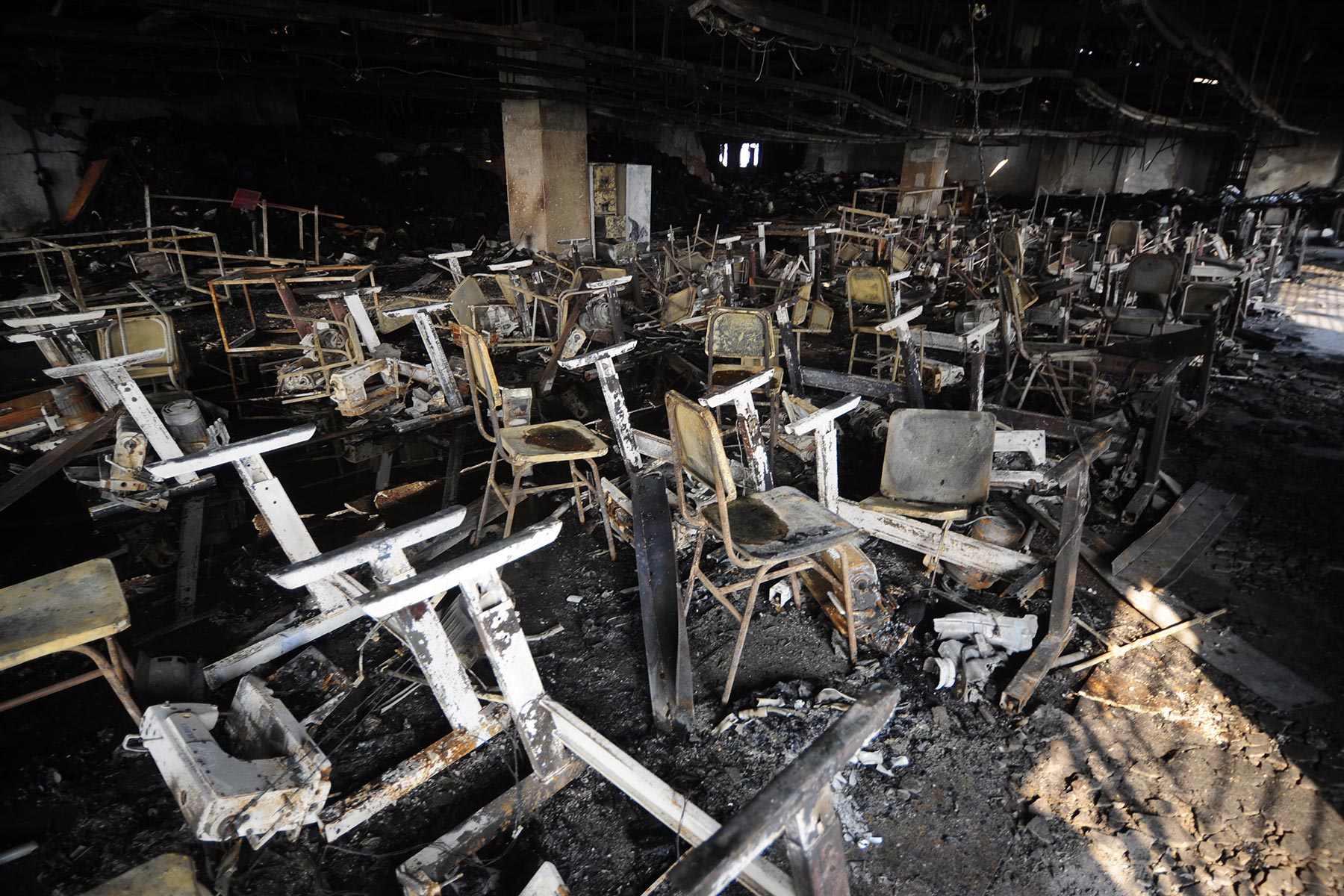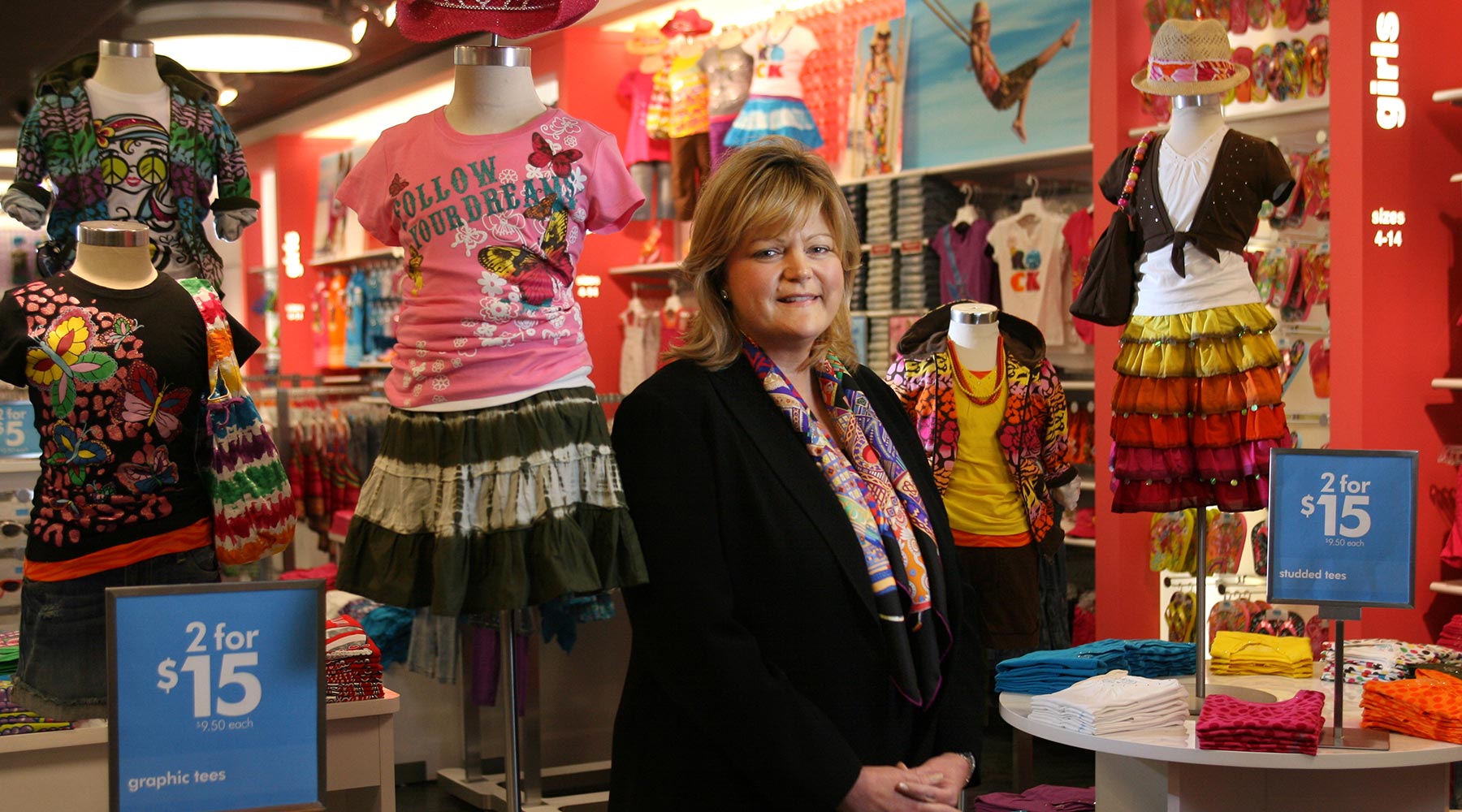
Sack, cloth and ashes
Children's Place CEO's 'reign of terror' has seen staff fired, activists arrested
It was the arrest that clinched it for the Children’s Place. Mahinur Begum, a survivor of the 2013 collapse of the Rana Plaza garment factory complex in Bangladesh, was at the New Jersey headquarters of the U.S. children’s clothing company in March along with 26 other activists. She wanted to ask the company’s CEO, Jane Elfers, to increase compensation to the victims of the collapse. But after the protesters went into the office, someone called the cops. All the activists were handcuffed and charged with trespassing.
“For Mahinur, it was a double tragedy,” says Kalpona Akter, a Bangladeshi labor rights activist who was also there. “She was trapped in Rana Plaza for 24 hours and now they’re arresting her?”
The arrests were a public relations nightmare for TCP. As Rana Plaza’s anniversary approached, anti-sweatshop activists seized on the incident and launched the website OrphansPlace.com and a matching Twitter account, making plans to picket 25 Children’s Place stores around the country. After resisting demands for a larger payout for more than a year, the company finally caved. On April 23, TCP wired more than $2 million into the Rana Plaza victims’ fund.
But bad press continues to dog the clothing retailer and especially its CEO. In March, two activist hedge funds penned a scathing letter to TCP’s board chair, citing Elfers’ “egregious” salary and her lack of “managerial expertise,” resulting in “constant executive turnover.” On anonymous job review website Glassdoor, only 30 percent of posters approve of her. One memorable 2014 review likens working at the company’s New Jersey head office to “drowning and someone hands you a bowling ball.” The reviewer goes on to describe headquarters under Elfers as a “hostile work environment cultivated from the highest level down … [where] employees are disposable.” The reviewer also offers a specific critique that may shed light on a more troubling corporate culture: “This company attempted to force me to ignore compliance regulations.”
Under Elfers, the company has reduced its orders from China and significantly increased them from Bangladesh. Despite the lessons of Rana Plaza — and TCP’s own promises to improve safety — many say it falls dangerously short of responsible business practices.
When the eight-story Rana Plaza, just outside Bangladesh’s capital city of Dhaka, collapsed on April 24, 2013, 1,129 people were killed and thousands more injured. President Barack Obama swiftly dumped Bangladesh from the list of developing countries eligible for reduced import tariffs.
The Children’s Place initially denied it had anything to do with the disaster. “While one of the garment factories located in the building complex has produced apparel for the Children’s Place, none of our product was in production at the time of this accident,” spokeswoman Jane Singer told the Associated Press. But a few days later, The New York Times dug up customs records proving that a factory from the New Wave retail group in Rana Plaza had sent TCP a massive shipment just weeks before the collapse. In fact, in a 2013 interview with Canada’s CBC, New Wave owner Bazlus Samad said his company was producing garments for the Children’s Place when the building collapsed.
For close to a year, the company refused to pay any compensation. Finally, in March 2014 TCP paid $450,000 to a fund established to help survivors and the families of the victims — about 1/17 of the requested $8 million and an even more minuscule sum compared with Elfers’ $17 million compensation package the year before the collapse. (In contrast, the British chain Primark, which also sourced clothes from a New Wave factory, pledged to donate $6.3 million, or $10,500 for each of the 600 victims in that factory.) At the time of the Rana Plaza disaster, Bangladesh’s minimum wage was just $38 a month. Though TCP’s final $2 million donation was less than was hoped for, it helped the fund reach its $30 million goal in June.
The aid is necessary and welcome, activists say, but little has changed on the ground. More than two years after Rana Plaza, the Children’s Place continues to purchase garments from Bangladeshi factories that are in danger of collapsing and have no fire safety plan. And TCP’s pledges ignore the real cause of the industrial accidents that plague the country’s garment industry: its razor-thin margins. These economic strictures make it almost impossible for suppliers to meet the prices demanded by TCP and other international brands and still adhere to their suppliers’ code of conduct, which bans child labor, forced labor and unsafe working conditions.
For years Bangladeshi workers have raised concerns about unsafe working conditions and low pay. But no one is listening — least of all Elfers, who former employees say has allowed the bottom line to trump ethical considerations at the Children’s Place. When she was hired as CEO in 2009, Wall Street cheered her arrival as a change agent who could clean up shop. Her predecessor, Ezra Dabah, who ran TCP from 1991 to 2007, was forced out by the board after being accused of financial impropriety and leading a disastrous attempt to open Disney-branded clothing stores. Crain’s, the New York business weekly, cooed, “Children’s Place gets a grown-up.”
Following industry trends, Elfers cut production costs by terminating many Chinese suppliers contracted under Dabah in favor of vendors in Vietnam and Bangladesh who were willing to produce similar clothing for less money. Even after the Rana Plaza disaster, TCP continued to increase its orders from Bangladeshi factories, many of which have poor labor conditions and unsafe structures.
Source: Datamyne shipping records
Note: From 2004-2015, 24.5 percent of all clothing came from Bangladesh; 20.8 percent from China. “All others” includes more than 40 countries that ship to the Children's Place, including Cambodia, Vietnam, Lesotho, Indonesia and India.
Very little data is available for some years, particularly 2006-07 and 2009-10. During these flat spots, the Children's Place used a Customs and Border Protection program that allows U.S. companies to redact their shipping documents to hide the names and locations of their suppliers abroad.
Things seemed to get worse in 2011 when Elfers allegedly forced out Mark Rose, the company’s well-regarded supply chain head. The following year, according to a source who would not speak on the record, she eliminated the entire 10-person quality assurance department, a team crucial to ensuring that supplier factories operate within the company’s code of conduct and make clothes of consistent quality and size. If it seems difficult to believe that Elfers would eliminate a department that handled such a critical function, former employees describe a corporate culture that didn’t value competency.
Almost a dozen former staffers describe an environment at TCP where supplicants rose through the ranks while anybody who disagreed with Elfers was trampled. During her tenure, the company has lost at least 12 senior staffers. But the board didn’t do enough to check Elfers’ power, says one former midlevel employee who spoke on condition of anonymity: “I don’t understand how there is a board of directors that allows this stuff to happen. I just know so many people who left there broken. And very talented people.”
A former high-level employee who was pushed out by Elfers concurs with this description. “I would call it Jane’s reign of terror,” he says. And the board approved the staff turnover because “she has [Brad Cost] her personal attorney as her chief legal counsel, who controls all the information that goes to the board. And she’s got Larry [McClure], the head of HR, who has basically been awarded gigantic grants of stock to do all her dirty work.”
Cost and McClure did not respond to requests for comment.
Zeeshan Haider, a retail analyst who covers clothing for IBISWorld, an investment research firm, agrees. “If the company is badly reviewed by its employees and there is a lot of employee turnover, especially executives at high levels, that could be one of the reasons for the structural inefficiencies.” When top management changes every few years, he says, “there is no consistency in terms of your planning, and that definitely does trickle down to your bottom line and negatively influences it.”
To the rank and file, Elfers seems remote. “I mean, when the previous CEO was there, if we had to work late he was there with us, see. He was encouraging, he was very much a part of the company,” says the first former employee. “As far as I could tell, [Elfers] was upstairs on her throne and she really distanced herself from the process, so I really had very little dealings with her, because she didn’t get her hands dirty. She wasn’t involved with people like me who were creating the product.”
This dissatisfaction is seconded by financial news website 24/7 Wall St., which ranked TCP among “America’s worst companies to work for.” Despite the outpouring of negativity about the company, more than a dozen former TCP employees, including Rose, declined or ignored requests to talk about their employment, with many citing nondisclosure agreements. “She really ruled with an iron fist and fear tactics,” says the first former employee. “It wasn’t pleasant. I just don’t want any backlash, and I’ve moved on from there.”
Under Elfers, TCP’s stock, very low during the recession, rose more than 80 percent; in comparison, the stock of TCP competitor Carter’s rose by 242.9 percent during the same period. At the Children’s Place, this stock price surge was accompanied by a sharp increase in the salary of the company’s new supply chain heads. Mark Rose, a Dabah-era holdover, made more than $500,000 in 2010. His first replacement, Peter Warner, lasted just a year. In 2014, Greg Poole, who replaced Warner, made more than $3.7 million in total compensation.
Requests for an interview with Elfers and Poole went unanswered.
From 2012 to 2013, Elfers’ compensation went from $17 million to $6.84 million, though it increased to $7.5 million in 2014. (In 2007, his last year as CEO, Dabah took home $1 million in salary, modest by industry standards; his total compensation that year was nearly $5 million.) But it’s common for executive pay to fluctuate from year to year, says Haider, so it’s important to look at compensation over a four-year period. “[TCP’s] CEO made around $43 million between 2011 and 2014,” he says. “The problem is that the CEO is being paid too much in relation to the company’s performance.” In his February 2015 report on the U.S. children’s retail clothing market, Haider notes that under Elfers, TCP’s share of the burgeoning children’s clothing market has declined from 15.4 percent in 2010 to 13.7 percent in 2015. Haider chalks up the decline to inefficiency. “The way the company is being run is not reflective of the on-the-ground realities,” he says.
Ezra Dabah, the longtime CEO of the Children's Place who was forced out in 2007, made nearly $5 million in total compensation that year. Charles Crovitz, the interim CEO, never touched $4 million. However, current CEO Jane Elfers made $17 million in total compensation in 2012.
Source: Securities and Exchange Commission, Schedule 14A forms, 2006, 2008, 2009-2015.
Some of the company’s investors agree. On March 11, the activist hedge funds Barington Capital Group and Macellum Advisors, which collectively own 2 percent of TCP’s stock, sent a heavily critical letter to the chairman of the board, citing Elfers’ inability to identify and retain talent, her poor merchandising decisions and her “excessive” pay, which earned an F rating from the pension fund watchdog Glass Lewis. “We find it remarkable that Ms. Elfers’s total compensation over the last three years was $35.1 million, which, for comparison, was $11.7 million, or 50%, greater than that of the CEO of Carter’s,” the activists write in the missive. “Carter’s … stock outperformed The Children’s Place by 130% over this three year period.”
In late May, the group settled with TCP’s board, which agreed to add retail veteran Robert Mettler as a member. But larger changes are brewing. TCP recently retained Goldman Sachs to explore a merger or acquisition with another clothing company or firm. Both Macellum and Barington declined to comment.
The shift of TCP’s production to Bangladesh has had a massive human cost. The disaster at Rana Plaza made safety concerns impossible to ignore. Yet, in the two years since the collapse, Elfers seems to have ignored them. Pre-Rana Plaza, too, there was cause for alarm. There were four major factory fires in Bangladesh from 2010 to 2013, which, according to Heather White, a supply chain expert and fellow at Harvard’s Edmond J. Safra Center for Ethics, were the outcome of the country’s weak enforcement of building codes and the desperation of factories that will do anything not to lose an order from an American brand. “There’s a lot of corruption, there’s a lot of conflicts of interests, and auditors shake down the factory,” White explains. “Brands are saying to factories they don’t want to pay for audits and are telling their customers we have independent, third-party auditors.” The conversation is fundamentally dishonest, she adds. But rather than actually enact real change, TCP has focused on creating the impression it is committed to change rather than enforcing its corporate code of conduct.
With both current and former TCP supply chain heads declining to comment, it’s impossible to know for sure what happened. But TCP seemingly ignored warning signs in Bangladesh. In December 2010, a fire at That’s It Sportswear, a supplier for Gap and other brands, killed 29 workers. In spite of this, the supplier’s sister factory, That’s It Fashions, continued to supply garments to the Children’s Place until May 2013. That’s It Fashions and That’s It Sportswear are both run by the mammoth industrial concern Ha-Meem Group; TCP continued sourcing from other Ha-Meem factories until 2014, when the U.S.-brand-funded industry group Alliance for Bangladesh Worker Safety called for the immediate evacuation of the top six floors of That’s It Fashions, based on the alliance’s report on the building.
Today, TCP seems to primarily rely on its suppliers’ individual corporate social responsibility departments and once- or twice-yearly inspections by private firms such as the London-based compliance group Intertek. But all the while, TCP presides over a system with loopholes big enough to fit a container full of onesies through. Just three months before Rana Plaza collapsed, Marcus Chung, the company’s head of social responsibility and vendor compliance, authored a blog post for the U.S. probusiness nonprofit Net Impact titled “Hope for Bangladesh.” In an apparent response to calls for safety in clothing manufacturing in the country, Chung wrote, “The apparel industry cannot ignore a fundamental commercial reality: Bangladesh has a ready supply of very capable garment factories that are filled with inexpensive labor and it’s not realistic for companies to simply stop sourcing from Bangladesh.”
But while Chung wrote of “responsible sourcing strategies and principled decision-making” and described meetings with factory owners, managers and corporate social responsibility professionals, there was little mention of speaking directly and independently to the workers whose very lives may depend on the decisions of people like him.
Kalpona Akter, the Bangladeshi activist, believes that brands have to actually talk to garment workers to understand the underlying problem. For conditions in Bangladesh to improve, she says, the companies have to pay their suppliers more and their suppliers, in turn, have to pay workers living wages.
If Akter ever gets face time with Elfers, she knows exactly what she will tell the CEO. “A person like her who has this power, she can really make a difference,” Akter says. “And we are not asking for charity. These workers [who died] made her clothes.”


